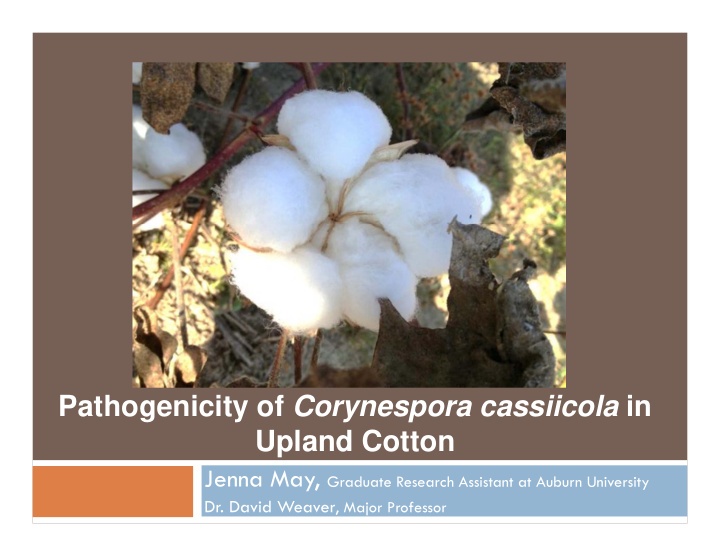



Pathogenicity of Corynespora cassiicola in Upland Cotton Jenna May, Graduate Research Assistant at Auburn University Dr. David Weaver , Major Professor
Research Objectives Develop a protocol for screening 1. large numbers of genotypes for resistance to Corynespora cassiicola using controlled conditions in the greenhouse Apply that protocol to evaluate 2. cotton genotypes represented by commercial cultivars and entries into the Regional Breeders Testing Network Secondary focus is to develop an 3. inoculation system for plants in the field, and assessing disease symptom development in a range of genotypes
Current Research at Auburn University Extension Dr. Kassie Conner Dr. Austin Hagan Dr. Kira Bowen “Disease intensification on all varieties continued until the onset of cooler and drier weather in mid-September.” “At the Gulf Coast Research and Extension Center, final defoliation levels varied from an estimated 38% for Stoneville 4288 to 83% for Phytogen 499 with most varieties suffering between 50 and 60% premature leaf shed.” “In a mid- and late season flex variety trial at the location, Phytogen 499, Phytogen 375, Phytogen 565, and DPL 1252 suffered similarly high target spot-incited defoliation.” -Hagan, et al. 2012
In the Lab • V8 agar medium: V8 juice, water, CaCO 3, agar, kanamycin -Dixon, et al. 2009 • Best grown in incubator at 23°C • Most researchers have prepared inoculum of this fungus by macerating agar cultures in distilled water, filtering them through cheesecloth and spraying the mixture onto plants -Onesirosan, 1975
In the Lab
Greenhouse Trials Spraying method has been used with Corynespora since 1945 two to four true leaf stage -Fulmer, et al. 2012 Individual bagging method with white trash bags Spray controls with water and bag
2013 Cotton Variety Trial entries Variety Season ID All-Tex DG CR108788 B2RF E 1630 All-Tex DG CT12353 B2RF E 1629 All-Tex Nitro 44B2RF F 1620 Americot AM 1511 B2RF E /F 1583 Americot AM 1550 B2RF E 1473 Americot NG 5315 B2RF F 1604 Croplan Genetics CG 3428 B2RF E 1597 Croplan Genetics CG 3787 B2RF F 1570 Deltapine DP 0912 B2RF E 1497 Deltapine DP 1034 B2RF E 1552 Deltapine DP 1048 B2RF F 1553 Deltapine DP 1050 B2RF F 1554 Deltapine DP 1137 B2RF F 1523 Deltapine DP 1212 B2RF E 1632 Deltapine DP 1219 B2RF F 1555 Deltapine DP 1252 B2RF F 1556 Deltapine MON 12R224 B2R2 E 1602 Deltapine MON 12R242 B2R2 F 1601 DeltapineDP 1321 B2RF E 1600 Dyna Gro DG 2285 B2RF E 1571 Dyna Gro DG 2610 B2RF F 1574 DynaGro CT 13414 E 1598 Fiber Max FM 1944 GLB2 E 1616 PHY 375 WRF E 1449 PhytoGen PHY 339 WRF E /F 1548 PhytoGen PHY 367 WRF E 1516 PhytoGen PHY 499 WRF E /F 1548 PhytoGen PHY 575 WRF F 1517 PhytoGen PX 3003-10 WRF E /F 1606 PhytoGen PX 3122-40 WRF E /F 1609 PhytoGen PX 4433-25 WRF E /F 1608 PhytoGen PX 4433-27 WRF E /F 1608 PhytoGen PX 4444-13 WRF E /F 1607 PhytoGen PX 4444-14 WRF E /F 1607 PhytoGen PX 5403-01 WRF F 1611 PhytoGen PX 5538-40 WRF F 1610 PhytoGen PX 5540-10 WRF F 1611 ST 4946 GLB2 E 1635 ST 6448 GLB2 F 1636 E - Early F - Full
5 4.5 2 nd trial: 5 varieties 1st trial: 8 varieties 4 -PHY 575 -PHY 4444-14 3.5 -DP 1048 -PHY 4433-25 3 -All Tex DG CT 12353 -DP 1048 2.5 -PHY PX 3003-10 -DG 2610 2 -ST 6448 -DP 1321 -PHY PX 5403-01 1.5 -DG CT 13414 1 -FM 1944 0.5 0 4 2 randomized greenhouse trials • 3.5 completed from the 2013 Alabama Cotton 3 Variety 2.5 2 Severities are shown on line graphs • using a 0-5 target spot severity scale 1.5 1 0.5 0
DP 1048 FM 1944 DP1321
Field Test at Plant Breeding Unit, Tallassee Alabama CORN CORN CORN CORN CORN CORN CORN CORN CORN CORN 101 CORN 201 CORN 301 CORN 401 CORN CORN 102 CORN 202 CORN 302 CORN 402 CORN CORN 103 CORN 203 CORN 303 CORN 403 CORN CORN 104 CORN 204 CORN 304 CORN 404 CORN CORN 105 CORN 205 CORN 305 CORN 405 CORN CORN 106 CORN 206 CORN 306 CORN 406 CORN CORN CORN CORN CORN CORN CORN CORN CORN CORN CORN CORN CORN CORN CORN CORN CORN CORN CORN CORN 501 CORN 601 CORN 701 CORN 801 CORN CORN 502 CORN 602 CORN 702 CORN 802 CORN CORN 503 CORN 603 CORN 703 CORN 803 CORN CORN 504 CORN 604 CORN 704 CORN 804 CORN CORN 505 CORN 605 CORN 705 CORN 805 CORN CORN 506 CORN 606 CORN 706 CORN 806 CORN CORN CORN CORN CORN CORN CORN CORN CORN CORN Randomized by Agrobase SQL
Field Trials- PBU @ EV Smith
Variety Test 100 Phytogen 575 90 Fibermax 1944 80 Deltapine 1050 70 Deltapine 1137 60 Deltapine 1252 50 Treated Phytogen 499 40 30 Control 20 10 0 PHY FM DP DP DP PHY 575 1944 1050 1137 1252 499
Recent appearances in the Southeast Georgia Alabama Plant Breeding Unit- EV Smith Gulf Coast Research Station “To our knowledge, this is the first report of this pathogen in Georgia.” -Fulmer, et al. 2012
Rating Corynespora cassiicola Tennessee Valley Station Belle Mina, Alabama Prattville, Alabama Plant Breeding Unit Tallassee, Alabama Gulf Coast Station Fairhope, Alabama Regional Breeders Testing Network Tallassee, Alabama Tifton, Georgia
Recommend
More recommend